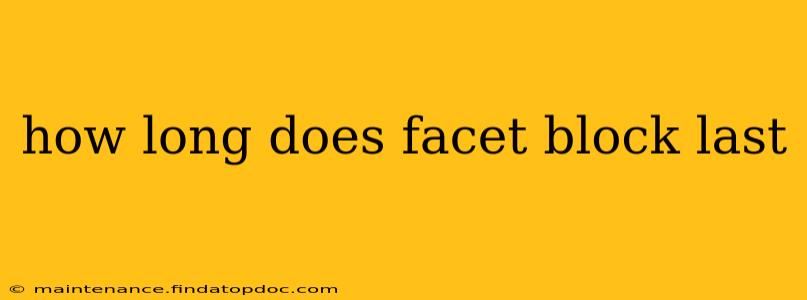Facet joint pain, a common source of lower back pain, can significantly impact daily life. Facet joint injections, also known as facet blocks, offer temporary relief by numbing the nerves supplying these joints. But how long does this relief actually last? The answer isn't straightforward, as the duration varies considerably depending on several factors. This article will explore the typical lifespan of a facet block's pain-relieving effects, delve into the reasons behind the variability, and address frequently asked questions.
What is a Facet Block?
Before discussing duration, let's briefly review what a facet block entails. A facet block is a minimally invasive procedure where a doctor injects a local anesthetic and often a corticosteroid into the facet joint. The anesthetic provides immediate pain relief by temporarily blocking nerve signals, while the corticosteroid reduces inflammation, offering longer-lasting effects.
How Long Does the Pain Relief Last?
The pain relief from a facet block is highly individual. While some individuals experience relief lasting only a few days, others may find it persists for several weeks or even months. A typical range is from a few days to several weeks. However, it's crucial to understand that this is not a cure. The goal is to provide temporary pain relief to assess if the facet joint is the source of the pain and to allow time for other treatments to take effect.
Factors Influencing Duration of Pain Relief:
Several factors influence how long the effects of a facet block last:
- Severity of the condition: More severe inflammation and nerve damage might lead to shorter-lasting relief.
- Individual response to medication: Metabolic rate and individual sensitivity to the anesthetic and corticosteroid play a role.
- Injection technique: Accurate placement of the injection is crucial for optimal results. A slightly misplaced injection may provide less effective and shorter-lasting pain relief.
- Underlying medical conditions: Other co-existing health conditions can affect the duration of pain relief.
- Lifestyle factors: Physical activity levels and adherence to post-procedure recommendations can impact the longevity of the pain relief.
What Happens After a Facet Block?
After the injection, you may experience immediate pain relief. However, it's important to remember this is temporary. The corticosteroids in the injection may take a few days to reach their full effect, so you might see increasing pain relief over the first few days. You should follow your doctor's post-procedure instructions carefully to maximize the duration of the effects. This might include avoiding strenuous activity for a period of time.
Will I Need Multiple Facet Blocks?
In many cases, multiple facet blocks may be needed over time to manage chronic pain. The number of injections needed varies greatly depending on individual circumstances. Some individuals find relief lasting several months from a single injection, while others might need repeat injections every few months or more frequently.
Can Facet Blocks Be Used Long-Term?
Facet blocks are generally not intended for long-term use. They are a diagnostic and therapeutic tool to assess the source of pain and provide temporary relief. Long-term use of corticosteroids can carry potential side effects, so doctors typically recommend other long-term treatment strategies if the pain persists.
Are There Alternatives to Facet Blocks?
Yes, there are other treatments for facet joint pain. These might include physical therapy, medication (such as NSAIDs or muscle relaxants), or other interventional procedures. Your doctor will help you determine the best approach based on your individual needs.
What Are the Potential Side Effects of Facet Blocks?
Like any medical procedure, facet blocks have potential side effects. These are typically mild and include temporary bleeding at the injection site, infection, or allergic reaction. Severe side effects are rare.
This information should not be considered medical advice. Always consult with your doctor or a qualified healthcare professional to discuss treatment options for facet joint pain and to determine the best course of action for your specific situation. They can help you understand the potential risks and benefits of facet blocks and guide you toward the most effective treatment plan.
